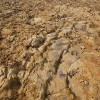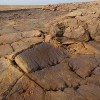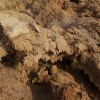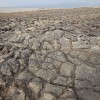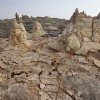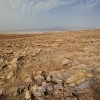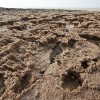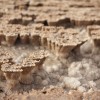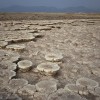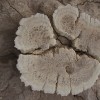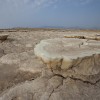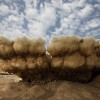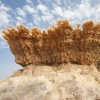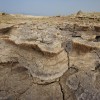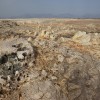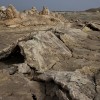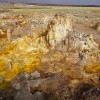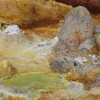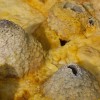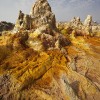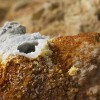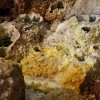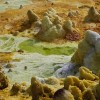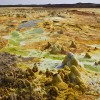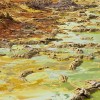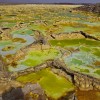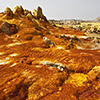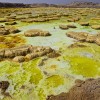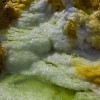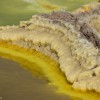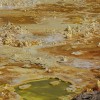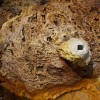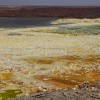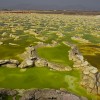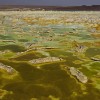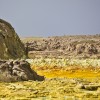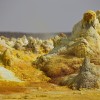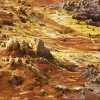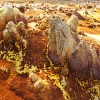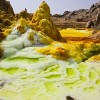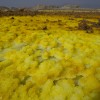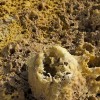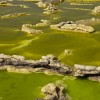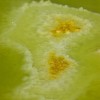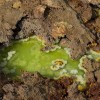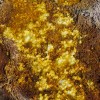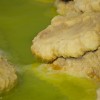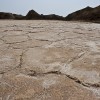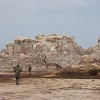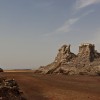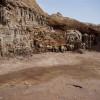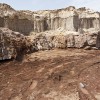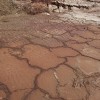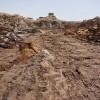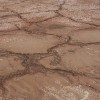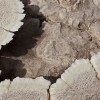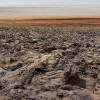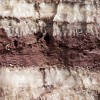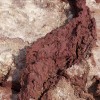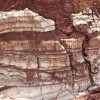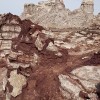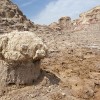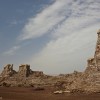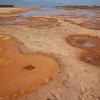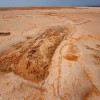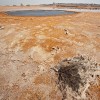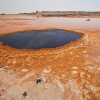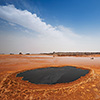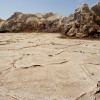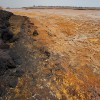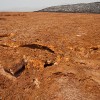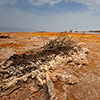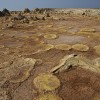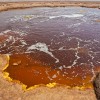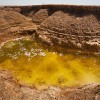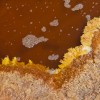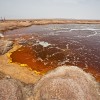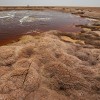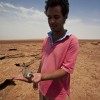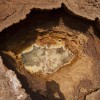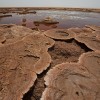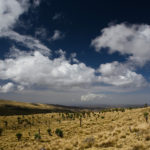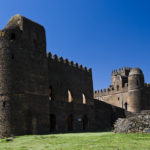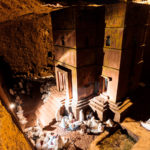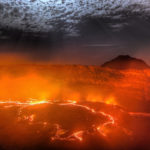Dallol – Like on a different Star
Dallol is the lowest volcanically active spot on Earth’s mainland and to boot Danakil’s hottest place. Not only oven-like air is holding a meeting there, also several chemically enriched pools and its richly coloured salts are courting your retina’s favour. If there’s acidic water pouring out of the ground to your feet and the surrounding air becomes sometimes pretty smelly and corrosive, then it doesn’t sound neither appealing nor inviting. Though visitors of this worldwide unique geothermal highlight will be rewarded with a visual firework of colours, forms and phantasy.
Experts are still at odds with themselves wether if Dallol is a volcano or “only” a geothermally active region. Once Dallol was a volcano, but its last eruption, a highly explosive phreatic one, terribly devastated the area and razed the mountain literally down to the ground. Today its highest peak measures only 60m above the already low desert land.
Though, deep inside things are still boiling and no step is done without hearing the omnipresent gurgling, as ground water, presumably also originating from near by Red Sea, is getting in contact with the earth’s hot interior. There it is washing out different salts and minerals and takes them a piggy-back way, soluted in its steam, back to the earth’s surface, where the sun is evaporating the water and the minerals and salts remain.
Once having reached the surface, sulphur and minerals are having a party among bubbling acid puddles and exploding colours, making the scenery looking everything but terrestrial for human eyes.
Even if there’s no lava coming to daylight, Dallol is pretty active and also dangerous. Acid is surely the last thing on earth you want to see on your skin and also the ground you’re walking on is sometimes pretty brittle and full of fumaroles and other little vents.
The enormous desert heat does the rest as its keeping the gas from cooling down and making the puddles evaporate further. In particular things get unbearable after 10 o’clock and without breathing protection even perilous. On the ground the gas concentration can become so high, that kneeing down to get a better photo perspective can result in a black out and suffocation.
Walking about the Dallol region without breathing protection is a pretty risky business, as you never know what’s coming out of the ground and even with a gas mask you shouldn’t expose yourself too long to all those vapourish chemicals soluted in ambient air. Immediately that reminds me of my visit to the Kawah Ijen located in East Java, which was in terms of temperatures mere child’s play as remaining cool at an average of 50°C in the nonexistent African shade is something that only the devil is able to do. Hence it’s only a matter of time since your own sweat and saliva are mating with the sulphur vapours and start maltreating your wellness. For example my sweat got corrosive after a while and started to fret the metal of my watch.
Having a “peak height” of 60 meters only and still being located 48 meters beneath the sea level, Dallol also stands for the superlative of being the lowest appearance of volcanism on mainland. In local language of the Afar tribe the word Dallol stands for “place without return”, or “place of entrance to hell”. Stories shrouded in legends are telling mysteries about wanderers disappearing at Dallol on their way through the desert. Maybe they died of thirst, or fell into the acid puddles, or maybe they just went mad in view of a colourful scenery that truly is everything but terrestrial…
The way leads from the base of Dallol over sharp-edged lava rocks to the implosion crater’s centre. There, surrounded by a yellow-green sea where sulphur is floating on like sheets of ice, a small island of solid rocks is elevating, from where you can enjoy a great view over the whole volcano. Dallol’s western edge looks like a small canyon, whose heavily distorted rocks show how powerful the phreatic eruption was. On top of those travertines called columns of limestone is a layer of hardened mineralised salt, that is protecting the column’s head from erosion. Though, their flanks are getting carried away step by step.
Further out in the West you can see something that the local Afar only call “The Black Thing”; a spot, that for me personally is the weirdest and most surreal place I have ever on Earth. The speech is about a steel-blue pond surrounded by rust-red soil, located right next to a massy rock of black lava. There is only missing the liquefied clock hanging over a branch to complete your perception of being right inside of a scenery created by Salvador Dali. Though, the stink is horrible and reminds of a field pretty generously manured with pig slurry. Once you take off the breathing protection, your vomitting reflex gets pretty much stimulated. On the way back to Hamed Ela you will pass another group of bubbling acid pools. At first glance they look like a huge yellowish-brown therapeutic swimming pool, but are poisonous and for lost birds the beginning of a journey without return.
And also here, far away from civilisation, humans are taking influence on nature. In a region that is one of the most inhospitable of the world Indian investors put up a factory to fetch chemicals from Dallol. The first barracks are already standing and a gravel road leading from Agula to Hamed Ela has also been made.
